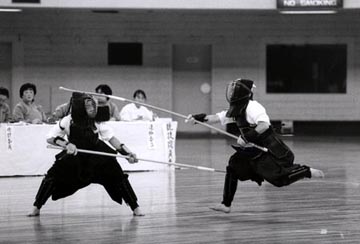
![]()

|
 |
 The naginata, a long pole with a sharp curving sword blade at one end, like the spear and sword is one of the ancient weapons of Japan. Its name was first visible in the Kojiki (A Record of Ancient Matters, 712) and was used by warrior priests during the Nara Period, around 750 A.D. Furthermore, in the paintings of battlefieled scenes made during the Tengyo no Ran (Tengyo Insurrection), in 936 A.D., the naginata can be seen in use. The naginata, a long pole with a sharp curving sword blade at one end, like the spear and sword is one of the ancient weapons of Japan. Its name was first visible in the Kojiki (A Record of Ancient Matters, 712) and was used by warrior priests during the Nara Period, around 750 A.D. Furthermore, in the paintings of battlefieled scenes made during the Tengyo no Ran (Tengyo Insurrection), in 936 A.D., the naginata can be seen in use.It was in 1086, in the book entitles Oushu Gosannenki (A Diary of Three Years in Oushu) that the use of the naginata, in combat, is first recorded. In this period the naginata was regarded as an extremely effective weapon by warrors, however by the time of the 1500s the introduction of muskets and mass battles forced the naginata into becoming a specialist weapon, wielded by warrior priests and women. By the Edo period, when the naginata was hardly ever used in combat, it became the representative weapon of samurai women. They would engage in training in order to polish the virtues of Harmony, Order, Chastity and Moderation. The traning would also develop the etiquette, style and personalities of the trainees. Furthermore a fashion developed where samurai families would display naginata in prominent places such as the entrances to theeir homes they would also be clearly visible in parades led by the local lords, and were even given as pressents to brides. Due to the influence of westernization after the Meiji Restoration the perceived value of martial arts, naginata included, dropped severely. It was from this time that the focus of training became the strengthening of the will and the forging of the mind and body. During the Showa period naginata became a part of the public school system. |
||
Once the ban had been lifted from the martial arts after World War II, a new modern sportive martial art was developed called 'Atarashii Naginata' using the long history and traditions of the naginata.
|